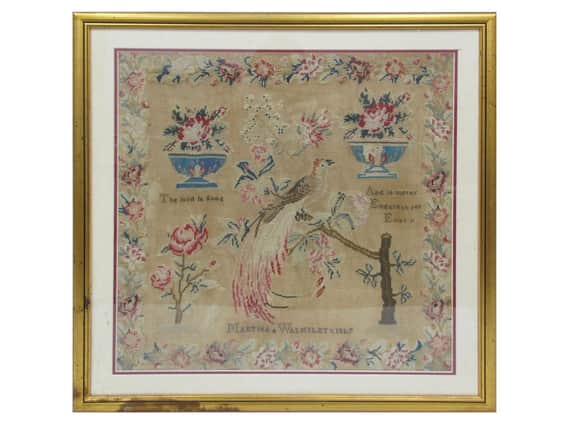Antiques: Material gain for quilts and samplers


I soon became hooked and loved all the floral and arts and crafts inspired designs. I enjoyed it so much I have just finished making a patchwork quilt, all hand-sewn, using over 2500 hexagonal pieces. I am very pleased with it, but I don’t think I will make another any time soon!
Patchwork quilts were first made in the 17th Century in Europe and America, as a way of showing off beautiful silks and printed cottons. Often ladies would stitch the quilts in groups called quilting bees, creating quilts to mark special occasions such a weddings or significant historical events, like Royal coronations. By the mid-19th Century the affordability of cotton had made patchwork and quilting a widespread pastime.
Advertisement
Hide AdAdvertisement
Hide AdPatchwork quilts always sell well at auction. As always, condition is key, the older the better and the intricacies of the design are all factors considered when valuing them for auction. Popular designs are medallion, where a large central patterned design is surrounded by plainer borders, or the log cabin, where strips of fabric are used which get progressively larger towards the outer edges.
Another popular needlecraft at auction are samplers. These are sometimes worked in wools but more commonly in silks and were usually made by young girls to enable them to learn the different stitches and needlecraft. The earliest samplers in Europe were made in the 16th Century but these are now very rare and it is mostly those that date from the 18/19th Century that we see coming up for sale in auctions.
The early examples are sometimes called band samplers as they have borders of different stitches surrounding a central design of flowers and animals often using up to twenty different colours but also sometimes all in white. Later in the 1800’s girls often made samplers at school and the alphabet and verses were added together with the girls name, age and date. Pictorial designs were also popular depicting buildings, animals, large potted plants and trees. Rarer and therefore more sought after samplers have an educational theme such as maps, multiplication tables, perpetual calendars and even puzzles. So, these are the ones to look out for, the more detail and interesting the design the better.
Samplers can be brought from as little as £50 up to several thousand pounds for early rare examples.
Advertisement
Hide AdAdvertisement
Hide AdAnother hobby in the Victorian period was rag rug making. It started during the Industrial Revolution as a way to up cycle old rags and clothing. They were made by pulling small pieces or strips of fabric through hessian to eventually make a rug with a shaggy or long pile effect. They can be quite colourful either in an abstract design or a more interesting geometric pattern. These can be picked up quite cheaply at auction usually under £50.